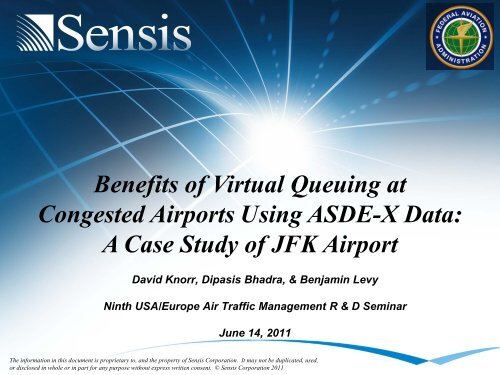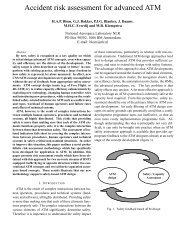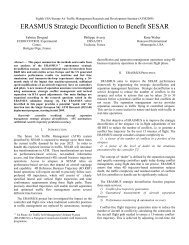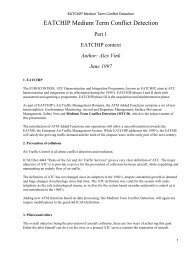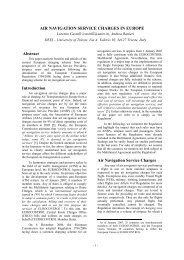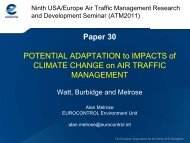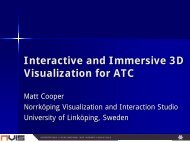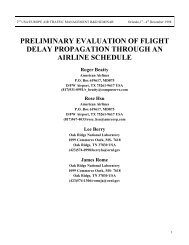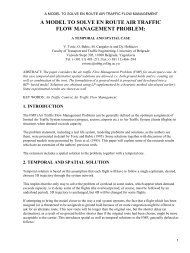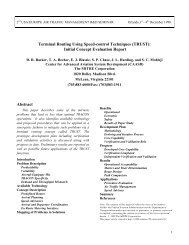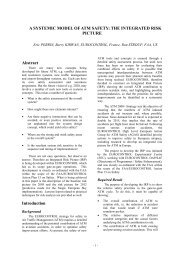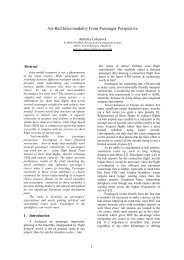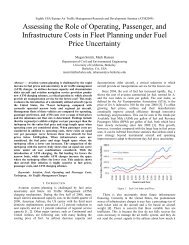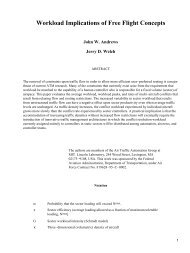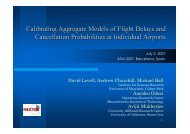10 - ATM Seminar
10 - ATM Seminar
10 - ATM Seminar
- No tags were found...
You also want an ePaper? Increase the reach of your titles
YUMPU automatically turns print PDFs into web optimized ePapers that Google loves.
Benefits of Virtual Queuing atCongested Airports Using ASDE-X Data:A Case Study of JFK AirportDavid Knorr, Dipasis Bhadra, & Benjamin LevyNinth USA/Europe Air Traffic Management R & D <strong>Seminar</strong>June 14, 2011The information in this document is proprietary to, and the property of Sensis Corporation. It may not be duplicated, used,or disclosed in whole or in part for any purpose without express written consent. © Sensis Corporation 2011
Outline•Main message of talk•Differences in performance and metrics of US and EU airports•Benefits calculation for a virtual queue•Metrics and events for airport surface operations•Benefits study results at JFK and other US airports•Issues for adoption of departure queue managementSensis Corporation Proprietary Data – See title page . © Sensis Corporation 20112
Differences in Taxi-Out Delays: EU vs. USWhat can be done? Policy implicationsTIME per flightEstimated excess time on flights to/from thePredictability(minutes)main 34 airports (2007)EURUSGate/ departureen-route-related 1.4 0.1 Lowholdingsairport-related 1.4 1.1 LowTaxi-out phase 3.7 6.8 MediumHorizontal en-route flight efficiency 2.2-3.8 1.5-2.7 HighTerminal areas (ASMA/TMA) 3.2 2.5 MediumTotal estimated excess time per flight 11.9-13.5 12.0-13.2•Differences in:– Policy (FCFS vs. slots)– Scheduling– Metrics definitionSensis Corporation Proprietary Data – See title page . © Sensis Corporation 20114
Taxi Efficiency Calculations and OOOI EventsNon-Movement AreaActive Movement AreaASPMGate-outWheels-OffASDE-XLeft GateEnter MAEnterDepQAtRwyWheels-UpEfficiency calculations (Gulding, 2011)Need “optimal” benchmark time to use with data aboveAlso called an “unimpeded” durationNeed high-quality surveillance over entire airport surfaceSensis Corporation Proprietary Data – See title page . © Sensis Corporation 20115
Determining Unimpeded Taxi Duration•Unimpeded taxi duration = total taxi duration - hold duration•Unimpeded taxi duration variability
Conditioning of Unimpeded Taxi Duration• None known• Runway location• Ramp/Gate/Terminal location• Taxi route between origin anddestination• Holds• Aircraft type• Airline/ownership• Distance along taxi route• Taxiway topology (e.g., turns,intersections)• Weathermean (min)std dev (min)13.5 <strong>10</strong>14.5 <strong>10</strong>14.5 97.1 4.52.2 < 1Sensis Corporation Proprietary Data – See title page . © Sensis Corporation 201112
Automatically-Derived Taxi-Out Routes•Movement area taxi-out duration on automatically defineddeparture taxi routes from twy WA to rwy 31L, 1 day of datablack tracesare singletonroutes, withhigh variability(σ = 6.3 min)UT: µ = <strong>10</strong>.2, σ = 1.6 min, n = 6UT: µ = 19.6, σ = 1.0 min, n = 3UT: µ = 20.9, σ = 6.3 min, n = 13UT: µ = 20.1, σ = 0.4 min, n = 2UT: µ = <strong>10</strong>.2, σ = 1.6 min, n = 6UT: µ = 16.9, σ = 3.7 min, n = 2Sensis Corporation Proprietary Data – See title page . © Sensis Corporation 201113
Unimpeded Taxi Duration vs. Path LengthSensis Corporation Proprietary Data – See title page . © Sensis Corporation 201114
Departure Taxi-Out EventsPush: 21:42Ramp exit: 21:52Clear runway: 22:18Queue entry: 21:57Wheels-off: 22:17Runway entry: 22:14Sensis Corporation Proprietary Data – See title page . © Sensis Corporation 201115
Taxi-Out Metrics Based on Events•Measure system performance with events to monitor changes•Well over ½ of taxi-out duration is excess time•Most of excess taxi-out duration is spent in the departure queuetaxi-out duration (minutes)regionunimpeded excess totalRamp 1.8 8.5 <strong>10</strong>.3Movement area (pre-queue) 3.6 1.4 5.0Departure queue 6.3 <strong>10</strong>.7 17.0Runway 1.0 2.2 3.2Total taxi-out 12.7 22.8 35.5Sensis Corporation Proprietary Data – See title page . © Sensis Corporation 201116
Benefits Study at JFK Airport•Before construction time period at 31L/13R•Before any metering in place in March 20<strong>10</strong>•Allows comparison to other US airports•Time period of study– August 8, 2008 - July 5, 2009– Data for 236 days with 125,034 operations– Data were not available during November, 2008 – January, 2009Sensis Corporation Proprietary Data – See title page . © Sensis Corporation 201117
AVI of DMAN Simulation at JFK AirportSensis Corporation Proprietary Data – See title page . © Sensis Corporation 201118
JFK Airport Runway Layout13R13LAAL/EGFJBUDAL/COM22R31R22L4L31L4RSensis Corporation Proprietary Data – See title page . © Sensis Corporation 201119
Taxi-Out Duration Varies with Carrier•DAL and its subsidiary COM have higher taxi-out durations•DAL/COM have 29% of traffic but higher frequency of delaysairlinecodepercentoperationsAAL/EGF 15%6050AAL COM DAL EGF JBUJBU 29%40DAL/COM 28%Others 28%Total <strong>10</strong>0%3020<strong>10</strong>013L 13R 22R 31L 4LSensis Corporation Proprietary Data – See title page . © Sensis Corporation 201120
JFK Departure Management Benefits•Benefit pool for maintaining virtual queues at 4 JFK Airportrunways (queue depth ≤ 5)•Basis: savings per 236 days of study period•Rates: $5.64/min fuel, $5.98/min (mx) at gate,15 kg fuel/min•Does not include cost of passenger timeRunwayMinutesSaved (<strong>10</strong>00s)Benefit(M USD)Excess fuelBurn (M kg)13R 123 1.43 1.8522R 166 1.93 2.4931L 320 3.72 4.804L 130 1.51 1.95Total 739 8.59 11.09Sensis Corporation Proprietary Data – See title page . © Sensis Corporation 201121
DMAN Time Savings per 236-day Study•Most of the departure queue savings are for 31L•Can develop this for range of target departure queue depthsSensis Corporation Proprietary Data – See title page . © Sensis Corporation 201122
Departure Queue Benefits at 22 US Airports•Taxi-out daily savings (hrs) for March-April 2009•Largest benefits for NYC-airports (JFK, EWR, PHL)•Subsidiary importance for ATL, CLT, IAH, ORD, and PHXTarget queue depth = 5Target queue depth = <strong>10</strong>Stroiney, 2011)Sensis Corporation Proprietary Data – See title page . © Sensis Corporation 201123
Predict DMAN Benefits from Demand/CapacityDaily Taxi-Out Savings from DMAN (hrs) at Target Queue Depth = 5<strong>10</strong>09080706050If you don’t have surveillance data,you might still be able to predict theDMAN benefitsfrom readily-availablecapacity and demand data40ATLPHL30CVGMSP20SFO ORDSLCCLTLASPHX<strong>10</strong>IAHLAXSEA FLL MEM DFWDENBOSDTWDCAMIASAN00 5 <strong>10</strong> 15 20 25 30TPA PDX BWI CLE MDW IAD % of ASPM observations when ADR > DEP RateLGAJFKEWRSensis Corporation Proprietary Data – See title page . © Sensis Corporation 201124
Issues with Departure Management, I•How precisely can operators comply with DMAN-prescribed spotrelease times?– What tools may help enable compliance?– Is ramp-area surveillance needed to prevent/monitor alleyway and ramp congestion– How does the use of metering points relieve pressure on gates, impact controllerworkload?– Would push-back time recommendations be useful?•What policy changes enable realization of DMAN benefits?– On-time performance definition (e.g., D0 metric)– Labor contracts– How much re-ordering in the virtual queue can be allowed from FCFS?Sensis Corporation Proprietary Data – See title page . © Sensis Corporation 201125
Issues with Departure Management, II•How do DMAN benefits compare with benefits fromother proposed DSTs?•How is the passenger experience improved?– To what degree can DMAN reduce missed passenger connections?Reduction in lost productivity•How is workload affected by DMAN? Which operationalconcepts are best in this regard? Who is affected (e.g.,ramp managers, air traffic control, flight crews, groundcrews)•How can compliance and equity be measured andassured?– How do airlines trade queue positions? Is it an anti-trust issue?Sensis Corporation Proprietary Data – See title page . © Sensis Corporation 201126
Main Message•Need same metrics, data, and analysis techniquesacross all airports to make policy to improve airportefficiency and performance and it must be based onpervasive, high-quality surveillance data and should notbe based on insufficiently detailed data or inference.Sensis Corporation Proprietary Data – See title page . © Sensis Corporation 201127
Thank you for your attentionAny questions, please?blevy@sensis.comSensis Corporation Proprietary Data – See title page . © Sensis Corporation 201128


